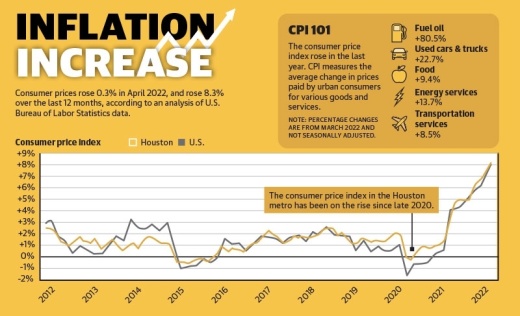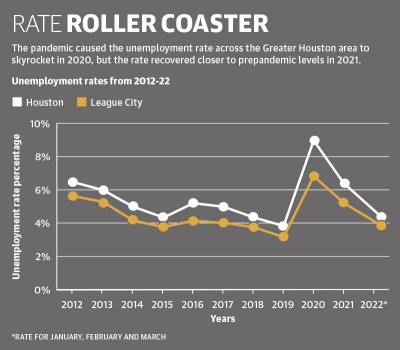April survey data from the Federal Reserve Bank of Dallas revealed 76% of Texas business owners said there has been an impediment to hiring people due to a lack of available applicants. Scott Livingston, director of economic development for League City, said businesses in the Bay Area have struggled in their own ways during the pandemic.
“It’s kind of the issue of just what appears to be not having enough people,” Livingston said. “There just seems to be a lot of competition for the workforce that is out there. There’s a lot of wage competition.”
Houston’s economy has recovered and rebounded from shutdowns, oftentimes resulting in more demand than there is supply, said Patrick Jankowski, senior vice president of research for the Greater Houston Partnership.
“We shut everything down in March and April of 2020, and we realized we didn’t need to shut it down,” Jankowski said. “So things started opening back up, and that’s when we saw the first surges in growth. The last quarter of 2021 was just incredibly strong. It was the strongest quarter on record for job growth.”
With businesses fully operational, they need as many hands as they can get, meaning less flexibility in scheduling than there was a year ago, Jankowski said.
Costs for goods and supplies are higher for mom and pop shops as well, making it more difficult to raise wages and leaving a gap in production as more people go out to shops or eat at short-staffed restaurants.
A March inflation update from the GHP reported a 8.5% rise in consumer prices nationwide compared to March of last year. The GHP also reported a 5.1% increase in job creation in 2021 with 151,800 positions created.
This influx of job opportunities has left many businesses struggling to find enough employees with some people being able to choose from an array of high-paying jobs. When faced with these hardships, local Bay Area businesses have adapted and persevered, officials said.
Ongoing challenges
Many of the issues businesses and cities face are related to the supply chain—the flow of goods from the producer to the customer—which was essentially halted when the pandemic first hit and nations ceased trading and shipping, Jankowski said.
Although many ports have opened back up, variant outbreaks still pose a threat to this system, leaving business owners and city leaders wondering when they will get their next shipments in, officials said.
League City has experienced supply chain issues when it comes to capital projects, said Sarah Greer Osborne, director of communications and media relations for League City.
“Projects that are normally expected to be completed by a certain date are being pushed or delayed by about six to nine months to get the materials that we need ordered,” she said.
Two projects that have been affected by the supply chain disruptions are the city’s League City Parkway improvement project and its new water line project from the Hwy. 3 pump station to the South Shore pump station. League City is spending $4.2 million to install traffic signals and make turn lane upgrades at League City Parkway intersections.
Additionally, the $22 million water line project will address the low water pressure part of the city experienced during the 2012 drought, according to city officials.
Due to materials not being available, the projects’ construction timelines have had to be extended, Osborne said.
“With the [traffic improvement project], instead of 12 weeks, we’re now looking at six months to get those poles, and that’s just because of the supply chain issue,” she said. “[For the water line project,] we bid out in July of last year. It wasn’t until January of this year that we could even get materials, and we actually had to find alternate materials because they weren’t available.”
Jankowski said other businesses have turned to Walmart or Target to stock their coolers with sodas and their shelves with cups as their usual providers limit distribution.
Alongside supply chain disruptions are staffing shortages. Local business leaders agreed people have come to expect higher pay for what are coined “behind-the-counter” jobs. Jankowski said he believes this is due in part to people becoming accustomed to working from home or having more flexibility during the peak of the pandemic.
Jankowski reported in February there were around 92,000 fewer workers in the Houston region now than a year prior.
With many companies rethinking their office structure, many developers are shying away from leasing out office space or building new businesses.
“People want to work from home. They don’t want to be in the office as much, and again, corporations are downsizing their leasehold footprint,” Livingston said.
Businesses adapting
Items being stuck in shipping limbo cause a sort of chain reaction that trickles down into local businesses and affects the way they operate, said Alice McCalla, a Clear Lake business owner.
One such business is promotional products supplier Fully Promoted, an international brand that has independently owned and -operated stores. McCalla, the owner of a Clear Lake-based branch as well as a Houston branch of the franchise, said she has had issues getting supplies out of China due to tightened COVID-19 restrictions.
“There are several cities in China that are still under lockdown from the new wave of COVID and then getting the product over here,” McCalla said. “It all just kind of impacts and adds to a potential problem.”
McCalla said that she was not very surprised by the issue and has been able to plan ahead for it.
With certain items not being immediately available, businesses have had to pivot. Fully Promoted found a specific type of hat was in high demand that McCalla said has been on backorder for quite some time.
“Specific brands have been on backorder for quite a while, but we have a number of alternatives that our clients actually ended up liking more, and they are available; we’re able to get them in there,” McCalla said. “Most of our vendors are larger companies, and so they actually anticipated it by bulking up on their inventory.”
Looking ahead
While staffing shortages and the access to supply lines are unfavorable, they are parts of the growing pains the economy is facing as it bounces back. Jankowski said he believes the economy has made an outstanding recovery. The GHP reported about 316,700 of the region’s 361,400 jobs lost had been recovered as of the end of 2021.
“No one thought the economy would rebound as strong as it has,” Jankowski. “A year and a half ago, when we talked about the recovery, people talked about it looking like a hockey stick—sharp drop and a slow, gradual increase; it looks like it’s been more like a check mark.”
All the while, businesses are facing higher operating costs and are starting to have to divert some of that burden on the customers. This can be seen in price increases of certain items or limits on menu options as the availability of certain goods varies. According to the U.S. Bureau of Labor Statistics, the cost of materials and components for construction increased 23.2% from March 2021 to March 2022.
Moving forward, Jankowski predicted the community will not see the same exponential growth seen in 2021, and businesses such as Fully Promoted will continue to implement their pandemic changes for the sake of their customers and employees.
“They’re simply going to go and do what it takes to keep the doors open,” Jankowski said. “So the small business by nature tends to be what the small business lacks in financial wealth with all the makeup for nimbleness.”







